Our class champion returns with minor updates, and the 2016 Yamaha YZ250F also celebrates a special anniversary.
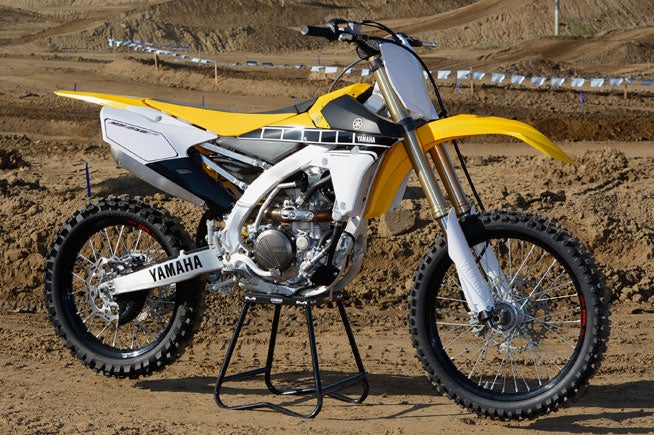
If not for its über-cool 60th Anniversary retro colors and graphics and 270mm front brake rotor, you might not know that the 2016 Yamaha YZ250F is any different than the championship-winning 2015 model it replaces.
That isn’t to suggest that Yamaha engineers are lazy. Quite the opposite, they’ve been pretty damn busy for the last few years, and it shows, as the YZ250F was completely redesigned for 2014 incorporating the fuel-injected, rearward-inclined engine configuration of its big sister, the YZ450F. The new model was an instant success both in the showroom and at the highest level of AMA motocross competition as factory rider Jeremy Martin ran away with the 2014 Lucas Oil Pro Motocross Championship while his teammate, Cooper Webb, won the 2015 AMA 250cc West Supercross title, giving the YZ250F an instant championship pedigree.
So, it is understandable that Yamaha was in no hurry to reinvent the YZ250F for 2016. In fact, most people who jump on a 2016 after riding a 2015 might not notice any difference at all. But rest assured that Yamaha has continued to comb through the YZ250F, and even though its evolution has slowed considerably, the 2016 model is different than its predecessor.
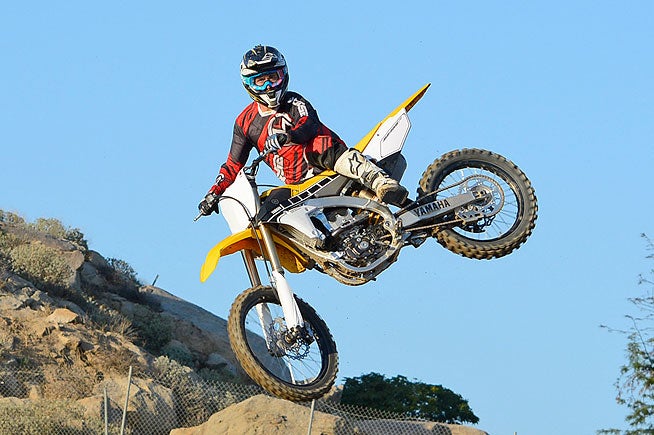
To prove how its quart-liter screamer has evolved, Yamaha called out to the legendary Perris Raceway in Southern California, for a late afternoon/evening test session with the YZ250F. When we arrived, we have to admit that were it not for the retro-sexy 60th Anniversary Limited Edition yellow and black photostrobe bodywork and graphics on our test unit, we might not gave been able to tell the difference between the 2016 YZ250F and the 2015. Its bilateral beam aluminum chassis is the same. Its body panel shapes are identical, and its rearward-inclined engine and mass-centralizing wraparound exhaust system are mirror images of the 2015 model.
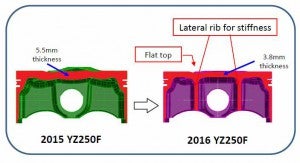
But delve inside the 2016 YZ250F’s 249cc liquid-cooled, DOHC four-stroke single and you will find that Yamaha has redesigned the YZ250F’s piston for the second straight year. This one features a flatter crown to effect a change in the combustion chamber velocity, and it does away with the sharp edges of the old one, altering combustion chamber velocity for more efficient filling and scavenging of the mixture. Despite the flatter top, the new piston still maintains the same 13.5:1 compression ratio as the old piston. Look underneath, however, and you will see that its F1-style bridged box design is also redesigned, featuring lateral ribs added to both sides of the wrist pin for greater rigidity. Even so, the new piston is 7% lighter than the old one. Combining that savings with a lighter piston pin, Yamaha shaved just over 18 grams of top-end weight from the engine. Any high-performance engine builder worth his or her salt will confirm that less top-end weight is always preferable for easier power production and greater reliability at stratospheric rpm.
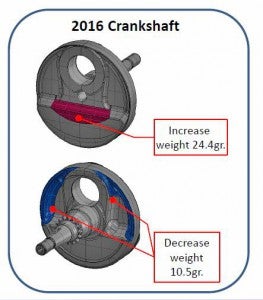 Yamaha also took a good look at the YZ250F’s crankshaft and realized that there was an opportunity to increase its rigidity and reduce high-rpm distortion, which also reduces harmonic vibration. Yamaha attacked the issue by making the big end pin is 20% tighter and adding thrust washers on both sides of the connecting rod, which features a new heat treatment process for greater strength.
Yamaha also took a good look at the YZ250F’s crankshaft and realized that there was an opportunity to increase its rigidity and reduce high-rpm distortion, which also reduces harmonic vibration. Yamaha attacked the issue by making the big end pin is 20% tighter and adding thrust washers on both sides of the connecting rod, which features a new heat treatment process for greater strength.
But that wasn’t all. In an effort to increase tractability and drive out of corners, the 2016 YZ250F engine’s internal balance is completely different than the 2014-2015 models. The new crankshaft’s counterweight features more mass than the old, resulting in a 24.4-gram overall weight increase, although some of that extra rotating weight is mitigated by a slightly redesigned counterbalancer shaft that features smaller weights than the previous design. According to Yamaha, the YZ250F’s crankshaft balance factor has been changed from 47% to 60%, and the balancer shaft ratio changed from 29% to 20% while also having its timing angle changed 48° (from 180°to 228°from TDC).
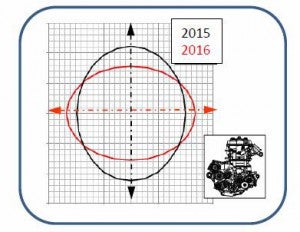
Our pro-level motocross tester, Ryan Abbatoye spent several laps aboard the YZ250F at Perris, flogging it over jumps, through whoops, and railing the track’s rutty corners before coming back and pronouncing that its overall power character simply doesn’t feel much different than the 2015. Abbatoye explained that the 2016 YZ250F “feels a little smoother, and it seems to get a little better drive out of corners, but overall I don’t think that most people will notice it.”
That’s hardly a complaint, as broad power is one of the 250F’s strong suits. Its 77.0 × 53.6mm bore and stroke deliver clean low-end snap that transitions into a potent midrange and finishes with an authoritative pull on top. There really isn’t any place that the stock machine will leave most riders wanting more thrust. It’s the kind of engine performance that turns big jumps into small ones and turns the YZ250F’s Bridgestone M403 rear tire into a berm shredder.
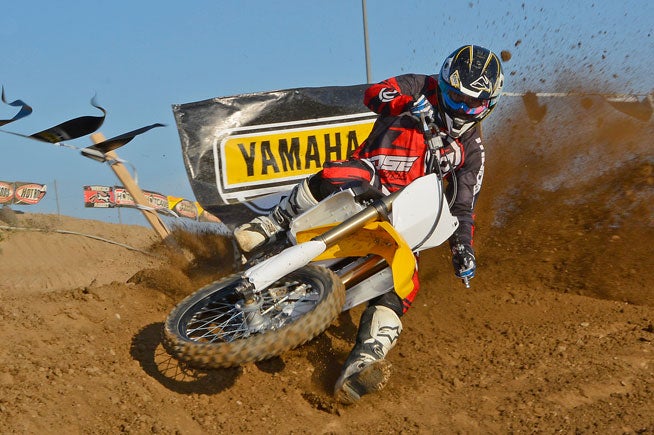
That said, the YZ250F’s power can be tailored in similar fashion to the way it can be done on the Kawasaki KX250F and the Suzuki RM-Z250. While the Kawi and the ‘Zook make use of ignition modules to alter the power characteristics, and the Honda’s ECU can be accessed via a laptop equipped with the proper software, the Yamaha’s ECU requires Yamaha’s accessory GYTR Power Tuner, but the nifty hand-held device is worth its $291.95 MSRP. The GYTR Power Tuner allows the user to adjust both the fuel and ignition curves individually. Fuel delivery can be adjusted within a 15-step range, with each change, equating to 3% per step for a total of 42% of adjustability. The ignition can be adjusted within a range of 14 steps, with each step changing the ignition timing by 1°, from -9° to +4°. The Power Tuner’s memory function can store up to nine custom maps, and its monitor function can keep track of such engine data as rpm, water temperature, air temperature, throttle position sensor and run time, as well as alert the user to various diagnostic codes at service time.
After spinning a load of laps, Abbatoye elected to try out settings created by Yamaha test rider and former AMA Supercross star Travis Preston to give the YZ250F a harder-hitting character that would be ideal for loamy tracks. It only took a minute to adjust the maps, and when Abbatoye returned after another long moto session, he had a grin on his face.
“It makes a really noticeable difference in the way the power comes on,” Abbatoye said. “The engine hits harder now, and it pulls so hard that I could hold each gear longer and still have enough drive to get over jumps that I had to shift to get over before. It’s pretty cool.”
Here are the settings that Preston recommended:
But even with the changes we made to the mapping, the fact is that you still have to shift the YZ250F—or any 250, for that matter—much more than a 450 in order to keep it churning, and Yamaha has put a lot of work into the 250F’s five-speed transmission to make it grab the next gear as smoothly and reliably as possible. To that end, the 2016 gets a new clutch boss and shift-stopper arm designed to improve its clutch engagement feel and shifting action. More transmission changes for 2015 include a redesign of the gear dog corners on third, fourth and fifth gears. The corners are radiused now, rather than chamfered, for smoother engagement.
Overall, our impression of the YZ250F’s transmission is the same as it was last year. Yamaha has come a long way in the shifting performance of its motocross machines, as the YZ250F delivers a smooth and positive engagement every time. It’s nice that Yamaha made more improvements for 2016, but they aren’t drastic. The same goes for the clutch, which has been improved for 2016 via a new machining process that gives the clutch hub a flatter surface to improve clutch plate contact. The clutch judder spring has also been eliminated entirely to give the clutch a more solid engagement feel.
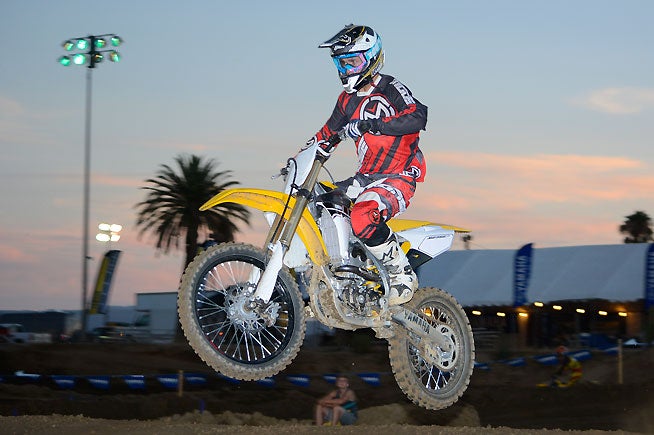
The YZ250’s bilateral beam aluminum chassis and KYB suspension have been excellent since their inception on the 2014 YZ250F, but Yamaha has tweaked the suspension slightly to achieve better balance front to back. The YZ250F’s fully adjustable Speed-Sensitive System inverted fork features slightly different valving specs this year with a reduction in low-speed compression damping and an increase in high-speed compression damping. It’s important to note that Yamaha continues to buck the trend toward air forks, one Yamaha official claiming that they factory has tried them all and still feels that its standard spring fork is better. We would definitely argue that is it just as good, with 12.2 inches of bump-wrangling travel that works well over a variety of track surfaces.
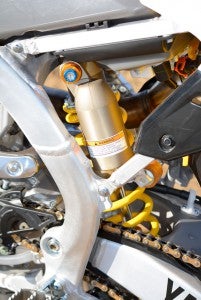 Out back, Yamaha addressed an issue that we had with the 2015 YZ250F whereby we felt the need to reduce the rear sag height to aid in weight transfer out of corners. The 2016’s fully adjustable KYB now comes from the factory with a slightly softer rear spring rate, 54 Newton-meters versus the 2015’s 56 Newton-meters, and Abbatoye duly noted that the new spring instantly makes the 250F feel more at home. Yamaha reduced the spring rate on its 2016 YZ450F with equally positive results.
Out back, Yamaha addressed an issue that we had with the 2015 YZ250F whereby we felt the need to reduce the rear sag height to aid in weight transfer out of corners. The 2016’s fully adjustable KYB now comes from the factory with a slightly softer rear spring rate, 54 Newton-meters versus the 2015’s 56 Newton-meters, and Abbatoye duly noted that the new spring instantly makes the 250F feel more at home. Yamaha reduced the spring rate on its 2016 YZ450F with equally positive results.
The YZ250F’s bilateral beam aluminum chassis is still rock stable on rough ground at higher speeds, and yet it can carve corners like a scalpel in bermed or flat corners. Slim ergonomics and a very flat and narrow seat allow the rider plenty of room to flick the YZ about while putting it anywhere on the racetrack. Mass centralization is the key, as the YZF’s 2.0-gallon fuel tank is located under the seat to keep fuel weight lower in the chassis. We also appreciate the top triple clamp, which offers a total of four bar positions for a total of 36mm of adjustment fore and aft.
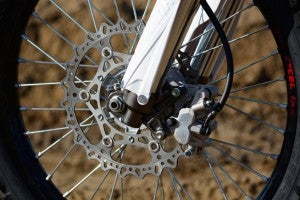 In an effort to give the YZ250F more stopping power, Yamaha has jumped on the 270mm front rotor bandwagon for 2016. It’s a welcome change, although we still think that braking performance is still one area where the 2016 could be improved even more. We’re still looking for a bit more bite up front to haul the YZ250F down from speed. Out back, the YZ’s 245mm rear rotor and single-piston caliper do a decent job of throwing out the anchors.
In an effort to give the YZ250F more stopping power, Yamaha has jumped on the 270mm front rotor bandwagon for 2016. It’s a welcome change, although we still think that braking performance is still one area where the 2016 could be improved even more. We’re still looking for a bit more bite up front to haul the YZ250F down from speed. Out back, the YZ’s 245mm rear rotor and single-piston caliper do a decent job of throwing out the anchors.
Like we said from the beginning, we’re big fans of the 2016 model’s 60th Anniversary graphics, which recall the glory days of Yamaha factory stars such as Bob Hannah, Broc Glover, Mike Bell and Ricky Burgett. While Yamaha’s standard blue and white graphics package looks great, it pales in comparison to the mighty yellow and black photostrobe markings, and we can’t imagine anyone not wanting them.
Yamaha has taken an evolutionary path with the YZ250F in 2015 and now again in 2016, but that’s because the 2014 models so darn good in the first place. We were thrilled with this generation of the bike right from the start, and Yamaha has done nothing to the 2016 model diminish our original stoke. The YZ250F is the same great 250cc motocross machine that it was in 2014 and 2015, only with a few subtle updates to keep it fresh. There is a slight price increase over the 2015 model, but the $7590 asking price (add another C-note for the 60th Anniversary colors) is one that we’d pay for a bike of this caliber any day and twice on Sunday.
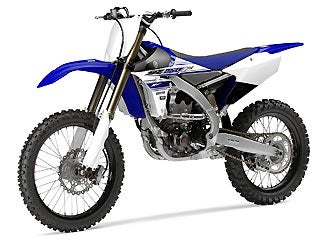
Specifications
2016 Yamaha YZ250F
MSRP: $7590/7690 (60th Anniversary Limited Edition graphics)
Engine: Liquid-cooled four-stroke single, DOHC four-valve head
Displacement: 249cc
Bore x stroke: 77.0 x 53.6mm
Compression ratio: 13.5:1
Fuel system: Keihin EFI, 44mm throttle body
Ignition: TCI
Transmission: Five-speed
Final drive: Chain
Frame type: Bilateral beam aluminum
Front suspension: Inverted KYB fully adj. fork w/Speed Sensitive System; 12.2 in. of travel
Rear suspension: KYB fully adjustable monoshock w/piggyback reservoir, 50mm piston; 12.4 in. of travel
Front brake: Nissin two-piston caliper 250mm wave-style disc
Rear brake: Nissin single-piston caliper 245mm wave-style disc
Front tire: Bridgestone M404-A 80/100-21
Rear tire: Bridgestone M403 100/90-19
Wheelbase: 58.1 in.
Rake: 27°, 08´
Trail: 118mm
Seat height: 38.0 in.
Ground clearance: 12.8 in.
Wet weight: 231 lbs. (claimed)
Fuel capacity: 2.0 gal.
Color choices: Blue & White / 60th Anniversary Limited Edition Yellow & Black

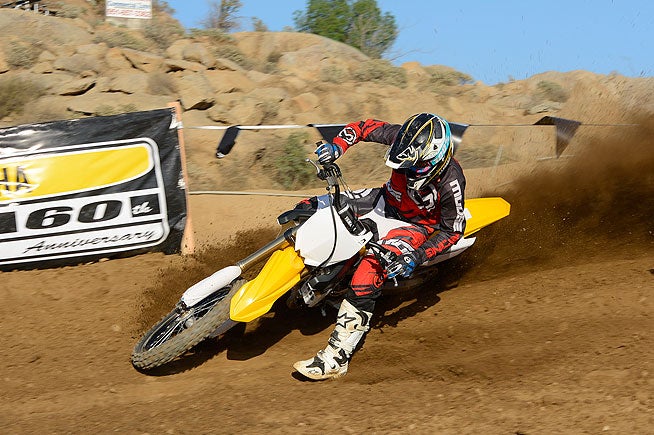
 Your Privacy Choices
Your Privacy Choices